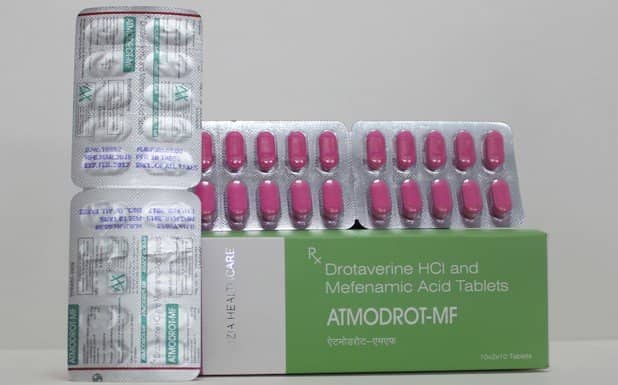
Composition
- Each Film Coated tablet Contains:
- Drotaverine HCL
80 mg
- Mefenamic Acid IP
250 mg
Packing
- 10X2X10
(Blister)
MRP
- 68
Overview
Atmodrot-MF is a combination of Drotaverine and Mefenamic Acid. Drotaverine and Mefenamic acid, an anti-spasmodic drug, is indicated for the symptomatic treatment of spasmodic dysmenorrhoea, colic pains including ureteric, biliary and intestinal colic. It is classified as selective phosphodiesterase inhibitor and acts as antispasmodic prescribed for pain and dysfunction caused by smooth muscle spasm.
Mefenamic acid is a non-steroidal anti-inflammatory drug (NSAID) that alleviates pain symptoms by inhibition of pain mediators associated with both isoforms of COX and prevents formation of prostaglandins and is used to treat mild to moderate pain, including menstrual pain, and is sometimes used to prevent migraines associated with menstruation.
Indications?
It is indicated mainly for the treatment of biliary tract spasm, gastrointestinal spasm, urinary tract spasm, and pain due to primary dysmenorrhea.
Contraindications
It is contraindicated in patients with renal impairment
It should not be used in individuals with hypersensitivity
PREGNANCY & LACTATON:
ATMODROT-MF should not to be used in pregnancy. The use of mefenamic acid in late pregnancy is not recommended because of the effects on the fetal cardiovascular system of drugs of this class. There are no controlled data in human pregnancy. Mefenamic acid is only recommended for use during pregnancy when benefit outweighs risk.
Side Effects
Very rare but the common side effects are:Hypotension
Headache
Tachycardia
Nausea
Vertigo
Dosage
Oral:
Disclaimer:To be taken only after consulting with the doctor.
Pharmacology
Pharmacodynamics:
Pharmacodynamics Properties of Drotaverine
Drotaverine inhibits the formation of phosphodiesterase-IV (PDE-4) which exerts contractile action in smooth muscles. The pharmacological action of Drotaverine is rapid and direct onto the smooth muscles present in the ureter and abdominal cavity. Direct inhibition of cyclic AMP (cAMP) results in correction of calcium levels at the spastic tissues and thereby alleviate smooth muscle spasm.
Mechanism of Action of Drotaverine:Drotaverine has spasmolytic and vasodilating action. It exerts its action by inhibiting phosphodiesterase enzyme IV. This will leads to a decrease in cyclic AMP level and reduction in calcium ions (Ca2+). The reduction of calcium ions will dilates the unstipped muscles and blood vessels strongly and relieves spasm of smooth muscles.
Pharmacodynamic Properties of Mefenamic acid:Mefenamic acid is a non-steroidal anti-inflammatory drug (NSAID) that alleviates pain symptoms by inhibition of pain mediators associated with cyclooxygenase pathway.
Pharmacokinetics:
Pharmacokinetics Properties of Drotaverine:
Absorption: Drotaverine is rapidly absorbed after oral administration.
Distribution: It is widely distributed in protein bound form.
Metabolism: Extensively metabolised in the liver.
Excretion: It is excreted mainly with the bile.
Absorption: Mefenamic acid is well absorbed after oral administration.
Distribution: It is distributed in the body in protein bound form.
Metabolism: It is metabolised in the liver.
Excretion: Mefenamic acid and its metabolites are excreted mainly in the urine.
Mefenamic acid has analgesic, anti-inflammatory and antipyretic action. It acts by inhibiting Prostaglandin (PGs) synthesis and their release at the site of injury. Prostaglandins cause tenderness and amplify the action of other analgesics. Mefenamic acid inhibits cyclo-oxygenase enzyme and antagonizes prostaglandin actions.
Other Drug Interactions
Drotaverine and Mefenamic acid may interact with analgesics, anti-muscarinics, Levodopa, benzodiazepines and other NSAIDs.